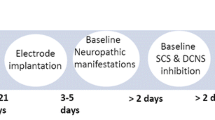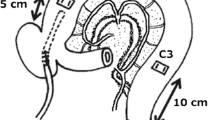Summary
The effect of unilateral sciatic nerve transection on behavioural responses produced by intrathecal administration of substance P (SP), neurokinin A, eledoisin and physalaemin was investigated in the rat. The injection of SP (3 nmol/rat) into the subarachnoid space was followed by reciprocal scratching, biting and licking of the fore- and hind-limbs. There was no observable difference in the behavioural response to SP between rats with nerve transection and sham operated rats at 5 days after operation. Whereas at 10, 20, and 30 days after nerve transection the response to SP was significantly increased as compared with sham operated rats. This phenomenon was also observed with neurokinin A (1.5, 3.0 and 6.0 nmol/rat), eledoisin (0.05 and 0.10 nmol/rat) and physalaemin (0.05 and 0.10 nmol/ rat) at 10 days after operation. Ipsilateral depletion of SP from the lumbar (L4-L6) spinal cord was observed at 5, 10, 20, and 30 days after the unilateral transection of the sciatic nerve. These results suggest that sciatic nerve transection may produce an increased response to tachykinins through an enhanced sensitivity of tachykinin receptors in the lumbar cord.
Similar content being viewed by others
References
Barbut D, Polak JM, Wall PD (1981) Substance P in spinal cord decreases following peripheral nerve injury. Brain Res 205: 289–298
Basbaum AL (1974) Effects of central lesions on disorders produced by multiple dorsal rhizotomy in rats. Exp Neuro1 42:490–501
Berman AJ, Berman D (1973) Fetal deafferentation: The ontogenesis of movement in the absence of peripheral sensory feed back. Exp Neurol 38:170–176
Dobry PJK, Piercy MF, Schroeder LA (1981) Pharmacological characterization of scratching behavior induced by intracranial injection of substance P and somatostatin. Neuropharmacology 20:267–272
Duckrow RB, Taub A (1977) The effect of diphenylhydantoin on self-mutilation in rats produced by unilateral multiple dorsalrhizotomy. Exp Neurol 54:33–41
Goldberger ME, Murray M (1974) Restitution of function and collateral sprouting in the cat spinal cord in the deafferented animal. J Comp Neurol 158:47–54
Harmar A, Schofield JG, Keen P (1980) Cyclohexamide-sensitive synthesis of substance P by isolated dorsal root ganglia. Nature 284:267–269
Henry JL (1976) Effects of substance P on functionally identified units in cat spinal cord. Brain Res 114:439–451
Hökfelt T, Kellerth J-O, Nilsson G, Pernow B (1975a) Experimental immunohistochemical studies on the localization and distribution of substance P in the cat primary sensory neurons. Brain Res 100:235–252
Hökfelt T, Kellerth J-O, Nilsson G, Pernow B (1975b) Substance P: Localization in the central nervous system and in some primary sensory neurons. Science 190:889–890
Hylden JLK, Wilcox GL (1981) Intrathecal substance P elicits a caudally-directed biting and scratching behavior. Brain Res 217:212–215
Hylden JLK, Wilcox GL (1982) Inthrathecal opioids block a spinal action of substance P in mice: Functional importance of both μ- and δ-receptors. Eur J Pharmacol 86:95–98
Jessell T, Tsunoo A, Kanazawa I, Otsuka M (1979) Substance P: Depletion in the dorsal horn of rat spinal cord of the peripheral processes of primary sensory neurons. Brain Res 168:247–259
Kawamura S, Sakurada S, Sakurada T, Kisara K, Akutsu Y, Sasaki Y, Suzuki K (1983) Antinociceptive effect of centrally administered cyclo(N-methyl-L-Tyr-L-Arg) in the rat. Eur J Pharmacol 93:1–8
Kimura S, Okada M, Sugita Y, Kanazawa I, Munekata E (1983) Novel neuropeptides, neurokinin α and β isolated from porcine spinal cord. Proc Jpn Acad 59 (B):101–104
Kuwahara H, Sakurada T, Sakurada S, Kisara K (1985) Behavioral effects of intrathecally administered substance P in rats with sciatic nerve section. Jpn J Pharmacol Suppl 89:p248
Maggio JE, Sandberg BEB, Bradley CV, Iversen LL, Santikarn S, Williams BH, Hunter JC, Hanley MR (1983) In: Skrabanek P, Powell D (eds) Substance K, a novel tachykinin in mammalian spinal cord, Substance P-Dublin. Boole Press, Dublin, pp 20–21
Massari VJ, Tizabi Y, Park CH, Moody TW, Helke CJ, O'Donohue TL (1983) Distribution and origin of bombesin, substance P and somatostatin in rat spinal cord. Peptides 4:673–681
Matsumura H, Sakurada T, Hara A, Sakurada S, Kisara K (1985) Characterization of the hyperalgesic effect induced by intrathecal injection of substance P. Neuropharmacology 24:421–426
Matsuto T, Yanagisawa M, Otsuka M, Kanazawa I, Munekata E (1984) The excitatory action of the newly-discovered mammalian tachykinins, neurokinin α and neurokinin β, on neurons of the isolated spinal cord of the new-born rat. Neurosci Res 2:105–110
Munekata E, Okada M, Kimura S, Sugita Y, Kanazawa I, Matsuo T, Otsuka M (1984) Neurokinin α and β, synthesis and pharmacological properties. Chem Lett 6:1013–1016
Murray M, Goldberger ME (1974) Restitution of function and collateral sprouting in the cat spinal cord: the partially hemisected animal. J Comp Neurol 155:19–36
Nakata Y, Kusuka Y, Segawa T (1979) Supersensitivity to substance P after dorsal root section. Life Sci 24:1651–1654
Piercey MF, Dobry PJK, Schroeder LA, Einspahr FJ (1981) Behavioral evidence that substance P may be a spinal cord sensory neurotransmitter. Brain Res 210:407–412
Randić M, Milet'c V (1977) Effects of substance P in cat dorsal horn neurones activated by noxious stimuli. Brain Res 128: 164–169
Sakurada T, Greves P Le, Stewart J, Terenius L (1985) Measurement of substance P metabolites in rat CNS. J Neurochem 44:718–722
Sastry BR, (1979) Substance P effects on spinal nociceptive neurones. Life Sci 24:2169–2178
Share NN, Rackham A (1981) Intrathecal substance P in mice: Behavioral effects and narcotic agents. Brain Res 211:379–386
Takahashi T, Otsuka M (1975) Regional distribution of substance P in the spinal cord and nerve roots of the cat and the effect of dorsal root section. Brain Res 87:1–11
Tessler A, Glazer E, Artymshyn R, Murray M, Goldberger ME (1980) Recovery of substance P in the cat spinal cord after unilateral lumbosacral deafferentation. Brain Res 191:459–470
Wall PD, Scadding JW, Tomkiewicz MM (1979a) The production and prevention of experimental anaesthesia dolorosa. Pain 6:175–182
Wall PD, Dever M, Inbar R, Scadding JW, Schonfeld D, Seltzer Z, Tomkiewicz MM (1979b) Autotomy following peripheral nerve lesions: experimental anaesthesia dolorosa. Pain 7:103–113
Wiesenfeld Z, Hallin RG (1981) Influence of nerve lesions, strain differences and continuous cold stress on chronic pain behavior in rats. Physiol Behav 27:753–740
Wright DM, Roberts MHT (1978) Supersensitivity to a substance P analogue following dorsal root section. Life Sci 22:19–25
Yaksh T, Rudy TA (1976) Chronic catheterization of the spinal subarachnoid space. Physiol Behav 17:1031–1036
Yasphal K, Wright DM, Henry JL (1982) Substance P reduces tail-flick latency: Implication for chronic pain syndrome. Pain 14:155–167
Author information
Authors and Affiliations
Additional information
Send offprint requests to T. Sakurada
Rights and permissions
About this article
Cite this article
Kuwahara, H., Sakurada, T., Sakurada, S. et al. Behavioural effects of intrathecally injected tachykinins in rats with peripheral nerve transection. Naunyn-Schmiedeberg's Arch Pharmacol 336, 656–660 (1987). https://doi.org/10.1007/BF00165757
Received:
Accepted:
Issue Date:
DOI: https://doi.org/10.1007/BF00165757




